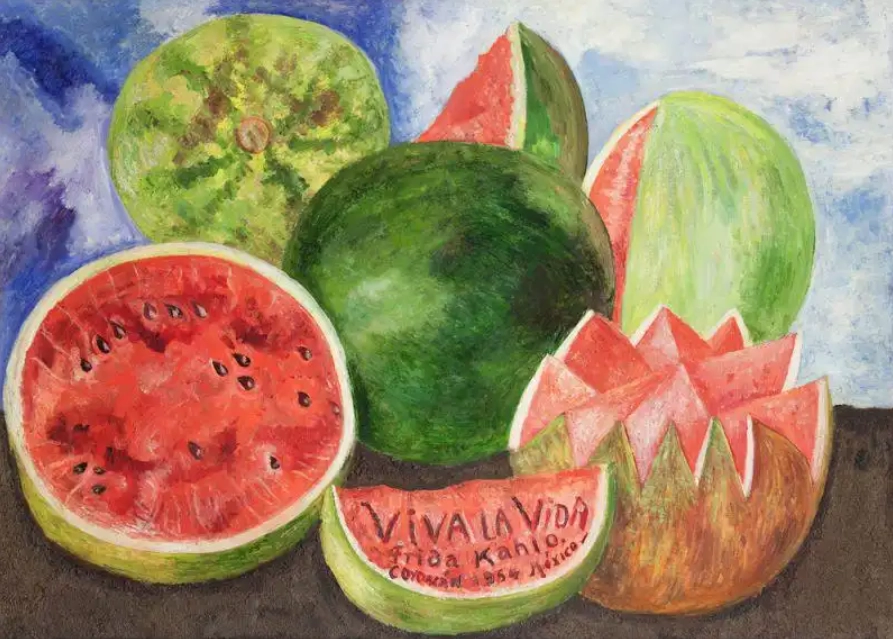The Evolution of 'Viva la Vida' into an Iconic Masterpiece


Within the realm of art, certain works transcend mere physicality to become cultural milestones, echoing through the ages and captivating collective imaginations. Among these, "Viva la Vida" stands tall—a masterpiece that has traversed from obscurity to iconic acclaim, captivating hearts and minds across generations. Join us on an enthralling expedition as we delve into the fascinating narrative behind 'Viva la Vida' and unravel the forces that propelled it to the zenith of artistic renown. This narrative is a testament to resilience, rediscovery, and the enduring ability of art to strike a chord with the human soul, transcending the constraints of time and space.
Exploring Frida Kahlo's 'Viva la Vida' : A Journey of Artistic Brilliance
Frida Kahlo stands as an enduring figure in the annals of art history, renowned for her arresting self-portraits and unapologetic self-expression. Her art transcends temporal and cultural boundaries, resonating with audiences across generations. Among her diverse oeuvre, "Viva la Vida," though initially overshadowed during Kahlo's lifetime, has emerged as a symbol of her resilience and profound celebration of life's intricacies. In this captivating journey through Kahlo's artistic brilliance, we embark on a profound exploration of the mesmerizing narrative behind "Viva la Vida" and its profound significance in Kahlo's artistic legacy.
Crafted in 1954, a year before her untimely passing, "Viva la Vida" (Spanish for "Long Live Life") serves as a poignant reflection of Kahlo's inner world and her deep-seated connection to her Mexican heritage. Through a vivid palette of colors and intricate symbolism, this still-life masterpiece offers a window into Kahlo's tumultuous life journey and her unwavering zest for life. Each brushstroke and carefully curated element within the composition encapsulates Kahlo's emotional depth and resilience, embodying her enduring impact on the art world. As we delve deeper into the layers of meaning within "Viva la Vida," we unravel the essence of Kahlo's spirit—a profound love for her homeland, an unwavering belief in the transformative power of art, and an indomitable resilience that transcends the confines of time and space.
Decoding Frida Kahlo's 'Viva la Vida' Symbolism
In the enigmatic world of Frida Kahlo's art, "Viva la Vida" emerges as a visual narrative brimming with symbolism and intimate reflection. On the surface, the painting showcases a vibrant array of meticulously rendered watermelons, each teeming with life. However, beneath this seemingly simple depiction lies a profound layer of meaning, intricately woven with Kahlo's personal experiences and inner struggles.
Central to the composition are the watermelons, a recurring motif in Kahlo's oeuvre. These luscious fruits symbolize both the exuberance of life and the protective shield she sought amidst adversity. Through the imagery of sliced-open watermelons, Kahlo unveils her own emotional vulnerabilities, laying bare the complexities of her inner world. Hovering above the watermelons, a hummingbird captivates the viewer with its delicate presence. In Mexican folklore, hummingbirds are revered as symbols of love and the afterlife, imbuing the painting with a sense of transcendence and eternal resilience. This juxtaposition of Kahlo's pain and the bird's ethereal beauty evokes a profound sense of contrast, inviting contemplation on the fragility and resilience of the human spirit.
From Unknown to Unforgettable
Despite its profound significance, "Viva la Vida" remained in relative obscurity during Frida Kahlo's lifetime. However, in the late 20th century, a series of influential factors propelled this masterpiece towards becoming an iconic symbol. Firstly, a resurgence of interest in Frida Kahlo's life and art, fueled by biographies, exhibitions, and renewed attention to her unique artistic perspective, played a pivotal role. As Kahlo's narrative captivated a new wave of art enthusiasts, "Viva la Vida" emerged from obscurity, garnering recognition for its rich symbolism and emotional depth.
Secondly, the feminist movement of the late 20th century shed new light on Kahlo's identity as a female artist. Her unapologetic exploration of pain, identity, and the female experience deeply resonated with feminists, transforming "Viva la Vida" into an emblem of empowerment and defiance. This feminist reevaluation revitalized interest in Kahlo's art, including this previously overlooked masterpiece. Lastly, the global fascination with Mexican art and culture significantly contributed to the painting's rise to prominence. "Viva la Vida" encapsulates the vibrant spirit of Mexican folk art, transcending geographical boundaries to captivate art lovers worldwide. As appreciation for Mexican heritage grew, Kahlo's works, including "Viva la Vida," found resonance on a global scale, solidifying their status as cultural treasures.
In conclusion, the transformation of "Viva la Vida" from obscurity to an iconic masterpiece stands as a testament to the timeless influence of art and the captivating narrative of Frida Kahlo's life and artistry. This vivid still life, brimming with symbolism and personal introspection, has evolved into a symbol of resilience, empowerment, and the joy of living. As we delve into the fascinating journey of 'Viva la Vida,' we gain a deeper understanding of art's ability to transcend generations and touch the hearts of diverse audiences worldwide. With its profound symbolism and emotional resonance, this painting continues to inspire and connect with people across the globe, serving as a lasting tribute to Frida Kahlo's indomitable spirit and her unwavering belief in art's transformative power to unite and uplift humanity.
Subscribe to our newsletter to get updated and enjoy a 10% voucher
Apr 10 2024 / Biography Art History



